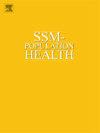Health insurance and epigenetic aging: Trends in a United States adult population
IF 3.1
2区 医学
Q1 PUBLIC, ENVIRONMENTAL & OCCUPATIONAL HEALTH
引用次数: 0
Abstract
Background
Health insurance plays an important role in reducing morbidity and mortality. Still, there is limited data examining the relationships of health insurance with biomarkers of aging that reflect morbidity and mortality risk.
Methods
We conducted a cross-sectional study of United States adults using data from the National Health and Nutrition Examination Survey (NHANES) to examine the relationships of health insurance with seven DNA methylation-based biomarkers of aging (epigenetic age): HannumAge, HorvathAge, SkinBloodAge, PhenoAge, GrimAge2, DNAm Telomere Length, and DunedinPoAm.
Results
Our analyses included 2315 participants with available health insurance and epigenetic aging data (mean [sd] age, 65.1 [9.3] years). Compared to the uninsured, having health insurance was associated with a 2.25-year lower GrimAge2 (95 %CI: -3.49, −1.02, P = 0.001) and a slower DunedinPoAm pace of aging (β = −0.04, 95 %CI: -0.06, −0.02, P < 0.001) in basic demographic-adjusted models. GrimAge2 (β = −1.42, 95 %CI: -2.75, −0.09, P = 0.04) and DunedinPoAm (β = −0.03, 95 %CI: -0.06, −0.01, P = 0.02) relationships were attenuated after additional adjustments for general health, body mass index (BMI), education, occupation, and poverty-to-income ratio. Model estimates were larger if insurance plans were more comprehensive and included dental coverage and/or single service plans. When considering categories of insurance, similar trends were observed with private insurance and public insurance plans (i.e. Medicare, Medicaid/CHIP, and other government plans), although private insurance relationships were more often statistically significant.
Conclusion
Our findings suggest that epigenetic aging measures may be useful for examining the relationship between health insurance and population health, with potential implications for policy decisions.
健康保险和表观遗传老龄化:美国成年人口的趋势
医疗保险在降低发病率和死亡率方面发挥着重要作用。然而,关于健康保险与反映发病率和死亡率风险的衰老生物标志物之间关系的研究数据有限。方法:我们对美国成年人进行了一项横断面研究,使用来自全国健康与营养调查(NHANES)的数据,研究健康保险与七个基于DNA甲基化的衰老生物标志物(表观遗传年龄)的关系:HannumAge, HorvathAge, SkinBloodAge, PhenoAge, GrimAge2, DNA端粒长度和DunedinPoAm。结果我们的分析包括2315名参与者,他们有可用的健康保险和表观遗传老化数据(平均[sd]年龄,65.1[9.3]岁)。与未参保者相比,参保者grimag2寿命降低2.25年(95% CI: -3.49, - 1.02, P = 0.001), DunedinPoAm衰老速度减慢(β = - 0.04, 95% CI: -0.06, - 0.02, P <;0.001)的基本人口调整模型。GrimAge2 (β = - 1.42, 95% CI: -2.75, - 0.09, P = 0.04)和DunedinPoAm (β = - 0.03, 95% CI: -0.06, - 0.01, P = 0.02)的相关性在对一般健康、体重指数(BMI)、教育、职业和贫困收入比进行额外调整后减弱。如果保险计划更全面,包括牙科保险和/或单一服务计划,则模型估计会更大。在考虑保险类别时,尽管私人保险关系在统计上更为显著,但在私人保险和公共保险计划(即医疗保险、医疗补助/CHIP和其他政府计划)中也观察到类似的趋势。结论表观遗传老龄化指标可能有助于检验健康保险与人口健康之间的关系,并对政策决策具有潜在的指导意义。
本文章由计算机程序翻译,如有差异,请以英文原文为准。
求助全文
约1分钟内获得全文
求助全文
来源期刊

Ssm-Population Health
PUBLIC, ENVIRONMENTAL & OCCUPATIONAL HEALTH-
CiteScore
6.50
自引率
2.10%
发文量
298
审稿时长
101 days
期刊介绍:
SSM - Population Health. The new online only, open access, peer reviewed journal in all areas relating Social Science research to population health. SSM - Population Health shares the same Editors-in Chief and general approach to manuscripts as its sister journal, Social Science & Medicine. The journal takes a broad approach to the field especially welcoming interdisciplinary papers from across the Social Sciences and allied areas. SSM - Population Health offers an alternative outlet for work which might not be considered, or is classed as ''out of scope'' elsewhere, and prioritizes fast peer review and publication to the benefit of authors and readers. The journal welcomes all types of paper from traditional primary research articles, replication studies, short communications, methodological studies, instrument validation, opinion pieces, literature reviews, etc. SSM - Population Health also offers the opportunity to publish special issues or sections to reflect current interest and research in topical or developing areas. The journal fully supports authors wanting to present their research in an innovative fashion though the use of multimedia formats.
 求助内容:
求助内容: 应助结果提醒方式:
应助结果提醒方式:


